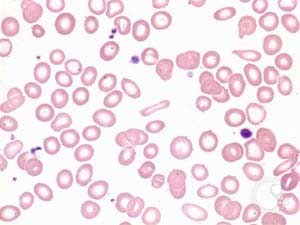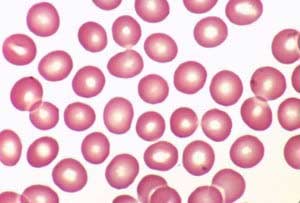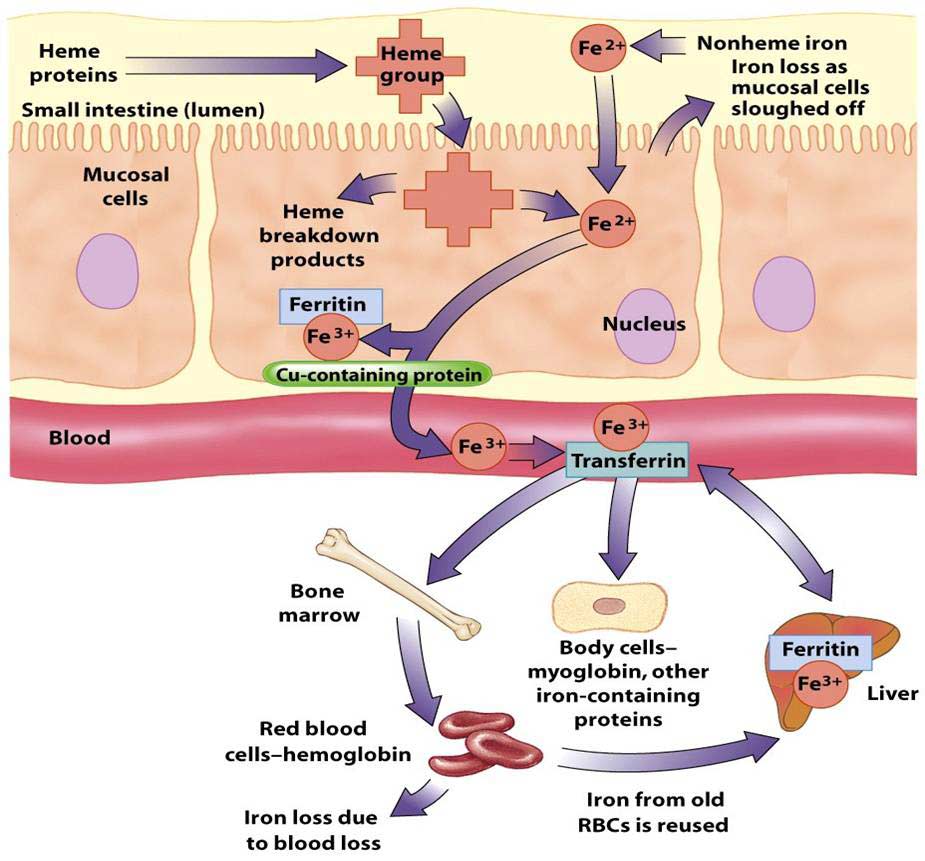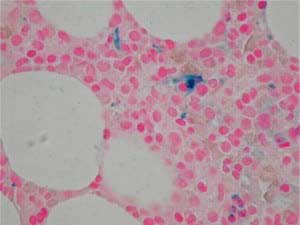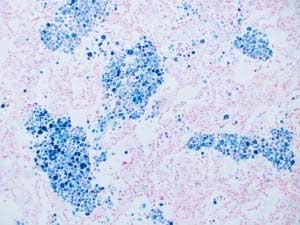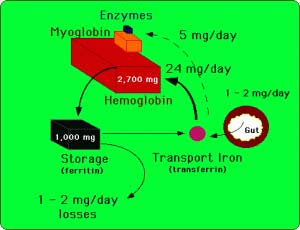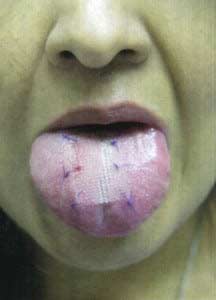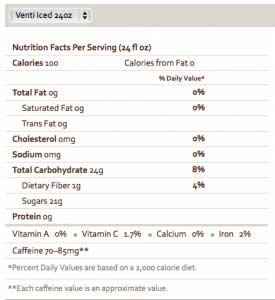Our First Featured Success Story
May 16, 2014 9:47 am
Patricia Welborn
Iron Deficiency Anemia
May 13, 2014 8:38 am
Iron Deficiency Anemia is a common problem in society and weight loss surgical patients. Anemia is usually easily treatable, although requires adequate surveillance and diligence in treatment. Microcytic/hypochromic (small pale colored red blood cells) erythrocytes indicate some inadequacy of structural matter, usually, not enough hemoglobin. This is most commonly due to an inadequate dietary supply of iron. In fact, iron deficiency anemia is the most common of all anemias.
Determining the cause of the iron deficiency is of pivotal importance in selecting appropriate therapy. Microcytic/hypochromic erythrocytes may also be seen in anemia of chronic disease, in thalassemia and in the sideroblastic anemias.
Symptoms of iron deficiency include:
- Being tired and feeling weak
- Getting frequent infections
- Feeling cold all the time
- Having swelling in the tongue
- Struggling to keep up at school or work
- Restless legs syndrome
- In children, having delayed mental development
- Feeling tired and weak
- Joint pain
- Abdominal pain
Possible Causes other than the above:
Blood loss is the most common cause of iron deficiency. Menstruation is the most likely reason in women ages 15 to 45 years. Iron deficiency anemia in adult men and postmenopausal women is most likely due to chronic gastrointestinal blood loss. Such losses are usually secondary to ulcerating lesions [peptic ulcer disease, mucosal trauma (hiatal hernias), drug ingestion (aspirin, nonsteroidal anti-inflammatory drugs, steroids, potassium), parasitic infections, inflammatory bowel disease and malignancy.
Undergoing several surgeries within a short time frame is also a source of blood loss. Frequently Duodenal Switch (DS) patients become anemic after their panniculectomy, breast reductions, arm or thigh lifts because of the short interval between operations. Also pregnancy after weight loss surgery can increase chances of developing iron deficiency anemia. After consecutive surgeries it is important to monitor your Iron, Ferritin and Transferrin, Total Iron Binding Capacity levels. Any drop in Ferritin or Transferin levels should be discussed with your DS surgeon. It is important to keep your levels with in normal limits because it can be challenging to bring these levels back up.Lack of dietary iron may cause anemia in infancy when the daily need for iron is not met by milk alone. This is why iron supplements are given to infants. Iron deficiency is a major cause of anemia in pregnancy.
Malabsorption of iron is a rare cause of iron deficiency in the general public but is seen in patients who have had a partial gastrectomy, RNY Gastric Bypass, or who have a surgical malabsorption, such as Duodenal Switch. Iron is absorbed through the duodenum and the first part of the jejunum. After DS there is only a small section (approximately 5cm) of the duodenum that comes into contact with the iron source in the GI tract. The remainder of duodenum and the jejunum after DS is now the biliopancreatic limb. There is an area of small intestine in the ileum that also absorb iron to a lesser degree in normal anatomy.
The following are definitions of Iron Deficiency Anemia diagnostic laboratory studies:
Ferritin is in essence an “iron buffer”, taking up excess iron or releasing iron as needed. Small amounts of ferritin, derived from iron stores, circulate in the plasma.
The amount of serum ferritin closely reflects iron stores, thus providing a readily measured assessment of body iron stores.
Ferritin is in essence an “iron buffer”, taking up excess iron or releasing iron as needed. Small amounts of ferritin, derived from iron stores, circulate in the plasma. The amount of serum ferritin closely reflects iron stores, thus providing a readily measured assessment of body iron stores.
-
- Transferrin, the major iron transport protein, is synthesized by the liver and macrophages (type of blood cell). Each molecule of transferrin can bind two at- oms of iron. Usually about one-third (25 – 45%) of the total transferrin is bound to iron (referred to as % saturation)Transferrin carries iron via plasma to cells throughtout the body, though the most important site of delivery is to the mar- row erythroblast. Non-heme iron (mainly Fe +++(Iron) ) is stabilized by gastric HCl; bound to mucin and then transferred to a mucosal cell surface receptor.
Most heme iron is catabolized to Fe ++ (Iron) and tetrapyrrole in the mucosal cell. In the mucosal cell the iron is bound to mobilferrin, transported through the cell to the submucosal capillary network where the iron is oxidized to Fe+++, bound to transferrin and delivered via the blood to the marrow and other tissues. Note that some iron is stored or “trapped” as ferritin in the mucosal cell. This “trapped” iron plays only a minor role in regulation of iron intake/loss as it is readily overwhelmed by ingestion of inorganic iron.
Total Iron Binding Capacity approximates a measure of transferrin. Serum iron is a measure of Fe bound to transferrin. Normally 25 – 45% of transferrin is bound to iron, ie. The % saturation of transferrin. In inflammatory and malignant conditions transferrin is decreased possibly due to macrophage degradation. Iron is decreased due to decreased release of iron from macrophages into the plasma. Iron deficiency is best screened for with serum ferritin levels (serum ferritin levels correspond to marrow stores). A serum ferritin of 12-307 ng/ml is the normal range.
The definitive test for iron deficiency is a Prussian blue stained bone marrow. The upper image demonstrates an absence of iron in the bone marrow macro-phages of an individual with iron deficiency.
Compare the upper image with the lower image of a normal bone marrow stained with Prussian blue and demonstrating coarse granular storage iron in macrophages.
Normal Iron Ranges:
Normal results of iron testing may be different for men, women, and children. Iron and TIBC are measured in micrograms per deciliter (mcg/dL). Normal results for iron are:
- 65 to 175 mcg/dL for men
- 50 to 170 mcg/dL for women
- 50 to 120 mcg/dL for children
Normal results for TIBC are 250 to 450 mcg/dL for men and women.
The diagram below shows the normal uptake, storage and loss of iron within the cell. An excellent explanation of iron transport physiology can be found here: https://sickle.bwh.harvard.edu/iron_transport.html
Iron is continually conserved and recycled for use in heme and non-heme enzymes. About 1 to 2 mg of iron are lost each day to sloughing of skin and mucosal cells of the gastrointestinal and genitouretal tracts. This obligate iron loss is balanced by iron absorption from the gastrointestinal tract. Only a small fraction of the 4 grams of body iron circulate as part of transferrin at any given time. Body iron is most prominently represented in hemoglobin and in ferritin.
Treatment:
There are different oral iron formulations available. I recommend heme iron instead of ferrous sulfate or ferrous fumarate. After 3 months of therapy it is necessary to repeat laboratory blood levels to determine the next course of action. Iron supplements along other medications should be stored away from children in “child proof” containers. Your pharmacist will be able to instruct you with the correct way of taking the iron supplements, and possible interference with other medications that you may be taking.
In severe anemia and/or iron deficiencies anemias resistant to oral iron supplementation, it may be necessary to have iron injections or infusions intravenously. If you have any questions please contact us either by email or phone.
In summary, iron deficiency anemia develops gradually. It also takes a great deal of time to build iron levels back up again. The importance of continued surveillance of laboratory studies is crucial after weight loss surgery. In addition, the treatment of iron deficiency anemia requires diligence in taking the iron supplement or reacting to the inability to absorb oral iron supplements by using iron infusions. Please contact our office if you have not had your yearly lab work or you may have your primary care physician order these studies.
Breaking news!
May 12, 2014 7:44 am
Weight Loss Tongue Patch !
April 22, 2014 7:35 pm
It is surprising to come across procedures such as “Weight Loss Tongue Patch” that are being performed now. Chugay et.al. (American Journal of Cosmetic Surgery, Vol.31, No. 1, 2014 26-33) reported a series of 81 patients with a mean weight loss of 16 lbs. (range 0-16.8). They concluded “While maintaining a strict low-calorie diet plan and adhering to a regular exercise regimen, patients using a tongue patch can achieve significant weight loss over a 30-day period, with relatively minimal procedural risk.
The “logic” of this procedure is that placing a mesh on the tongue makes swallowing painful and difficult. The patient is forced to maintain a liquid diet and this causes thus weight loss reported above.
The science and research of weight loss surgical procedures has centered around the metabolic aspect of obesity. Over the years we have moved away from the simple notion of obesity being only a function of over eating and lack of physical activity. The premise that obesity is a disease of energy imbalance is unproven to say the least.
In my opinion, this is a step backward in the surgical treatment of obesity. I always tell my patients to do their research before signing up for a procedure. This procedure is similar to tried and failed wiring of the jaws. It only created a short-term weight loss that is no more effective than any diet. The notion that a patient should be punished with pain to loose weight should not be tolerated by anyone.
StomaphyX does not reduce regained weight after a failed gastric bypass.
April 17, 2014 9:26 pm
Vitamin’s Physical State And Solubility are Two Different Things.
March 29, 2014 6:11 pm
Vitamins And Minerals
March 29, 2014 5:26 pm
|
Vitamins -Minerals |
Function |
Source |
Problems with deficiency |
|
B1 (Thiamine) |
Carbohydrate conversion, breaks down fats and protein, digestion, nervous system, skin, hair, eyes, mouth, liver, immune system |
Pork, organ meats, whole grain and enriched cereals, brown rice, wheat germ, bran, brewer’s yeast, blackstrap molasses |
Heart, age-related cognitive decline, Alzheimer’s, fatigue |
|
B2 (Riboflavin) |
Metabolism, carbohydrate conversion, breaks down fat and protein, digestion, nervous system, skin, hair, eyes, mouth, liver, antioxidant |
Brewer’s yeast, almonds, organ meats, whole grains, wheat germ, mushrooms, soy, dairy, eggs, green vegetables |
Anemia, decreased free radical protection, cataracts, poor thyroid function, B6 deficiency, fatigue, elevated homocysteine |
|
B3 (Niacin) |
Energy, digestion, nervous system, skin, hair, eyes, liver, eliminates toxins, sex/stress hormones, improves circulation |
Beets, brewer’s yeast, meat, poultry, organ meats, fish, seeds, and nuts |
Cracking, scaling skin, digestive problems, confusion, anxiety, fatigue |
|
B5 (Pantothenate) |
RBC production, sex and stress-related hormones, immune function, healthy digestion, helps use other vitamins |
Meat, vegetables, whole grains, legumes, lentils, egg yolks, milk, sweet potatoes, seeds, nuts, wheat germ, salmon |
Stress tolerance, wound healing, skin problems, fatigue |
|
B6 (Pyridoxine) |
Enzyme protein metabolism, RBC production, reduces homocysteine, nerve and muscle cells, DNA and RNA, B12 absorption, immune function |
Poultry, tuna, salmon, shrimp, beef liver, lentils, soybeans, seeds, nuts, avocados, bananas, carrots, brown rice, bran, wheat germ, whole grain flour |
Depression, sleep and skin problems, elevated homocysteine, increased heart disease risk |
|
B12 (Cobalamin) |
Healthy nerve cells, DNA/RNA, RBC production, iron function |
Fish, meat, poultry, eggs, milk and milk products |
Anemia, fatigue, constipation, loss of appetite, weight, numbness and tingling in the hands ad feet, depression, dementia, poor memory, oral soreness |
|
Biotin |
Carbs, fat, and amino acid metabolism (the building blocks of protein) |
Salmon, meats, vegetables, grains, legumes, lentils, egg yolks, milk, sweet potatoes, seeds, nuts, wheat germ |
Depression, nervous system, premature graying, hair, skin |
|
Folate |
Mental health, infant DNA/RNA, adolescence and pregnancy, with B12 to regulate RBC production, iron function, reduce homocysteine |
Supplementation, fortified grains, tomato juice, green vegetables, black-eyed peas, lentils, beans |
Anemia, immune function, fatigue, insomnia, hair, high homocysteine, heart disease |
|
Eyes, immune function, skin, essential cell growth and development |
Milk, eggs, liver, fortified cereals, orange or green vegetables and fruits |
Night blindness, immune function, zinc deficiency, fat malabsorption |
|
|
Calcium and phosphorus levels, calcium absorption, bone mineralization |
Sunlight, milk, egg yolk, liver, fish |
Osteoporosis, calcium absorption, thyroid |
|
|
Vitamin E |
Antioxidant, regulates oxidation reactions, stabilizes cell membrane, immune function, protects against cardiovascular disease, cataracts, macular degeneration |
Wheat germ, liver, eggs, nuts, seeds, cold pressed vegetable oils, dark leafy greens, sweet potatoes, avocado, asparagus |
Skin, hair, rupturing of red blood cells, anemia, bruising, PMS< hot flashes, eczema, psoriasis, cataracts, wound healing, muscle weakness, sterility |
|
Calcium |
Bones, teeth, helps heart, nerves, muscles, body systems work properly, needs other nutrients to function |
Dairy, wheat/soy flour, molasses, brewer’s yeast, Brazil nuts, broccoli, cabbage, dark leafy greens, hazelnuts, oysters, sardines, canned salmon |
Osteoporosis, osteomalacia, osteoarthritis, muscle cramps, irritability, acute anxiety, colon cancer risk |
|
Chromium |
Assists insulin function, increased fertility, carbohydrate/fat metabolism, essential for fetal growth/development |
Supplementation, brewer’s yeast, whole grains, seafood, green beans, broccoli, prunes, nuts, potatoes, meat |
Metabolic syndrome, insulin resistance decreased fertility |
|
Magnesium |
300 biochemical reactions, muscle/nerve function, heart rhythm, immune system, strong bones, regulates calcium, copper, zinc, potassium, vitamin D |
Green vegetables, beans & peas, nuts and seeds, whole unprocessed grain |
Appetite, nausea, vomiting, fatigue, numbness, tingling, cramps, seizures, personality changes, heart rhythm, heart spasms |
|
Selenium |
Antioxidant, works with vitamin E, immune function, prostaglandin production |
Brewer’s yeast, wheat germ, liver, butter, cold water fish, shellfish, garlic, whole grains, sunflower seeds, Brazil nuts |
Destruction to heart/pancreas, sore muscles, fragility of red blood cells, immune system |
|
Zinc |
Supports enzymes, immune system, wound healing, taste/smell, DNA synthesis, normal growth & development during pregnancy, childhood adolescence |
Oysters, red meat, poultry, beans, nuts, seafood, whole grains, fortified breakfast cereals, and dairy |
Growth retardation, hair loss, diarrhea, impotence, eye & skin lesions, loss of appetite, taste, weight loss, wound healing, mental lethargy |
|
COQ10 |
Powerful antioxidant, stops oxidation of LDL cholesterol, energy production, important to heart, liver, and kidneys |
Oily fish, organ meats, and whole grains |
Congestive heart failure, high blood pressure, angina, mitral valve prolapsed, fatigue, gingivitis, immune system stroke, cardiac arrhythmias |
|
Carnitine |
Energy, heart function, oxidize amino acids for energy, metabolize ketones |
Red meat, dairy, fish, poultry, (fermented soybeans), wheat, asparagus, avocados, peanut butter |
Elevated cholesterol, liver function, muscle weakness, reduced energy, impaired glucose control |
|
N-Acetyl Cystein (NAC) & Glutathione |
Glutathione production, lowers homocysteine, lipoprotein, heal lungs, inflammation, decrease muscle fatigue, liver detoxification, immune function |
Meats, ricotta, cottage cheese, yogurt, wheat germ, granola, and oat flakes |
Free radical overload, elevated homocysteine, cancer risk, cataracts, macular degeneration, immune function, toxin elimination |
|
Alpha Lipoic Acid |
Energy, blood flow to nerves, glutathione levels in brain, insulin sensitivity, effectiveness of vitamins C, E, antioxidants |
Supplementation, spinach, broccoli, beef, brewer’s yeast, some organ meats |
Diabetic neuropathy, reduced muscle mass, atherosclerosis, Alzheimer’s, failure to thrive, brain atrophy, high lactic acid |
What does elevated Alkaline Phosphatase level mean?
March 18, 2014 2:17 am
There are laboratory studies that can distinguish between 2 primary sources of the ALP. The two “isoenzymes” are bone ALP and liver ALP.
Endoscopy Procedures and Duodenal Switch
February 27, 2014 6:58 pm
Upper Endoscopy (Esophagogastroduodenoscopy- EGD)
Gastrointestinal endoscopic procedures can be done in patients after the duodenal switch operation.
An upper endoscopy in an intact anatomy, involves examination of the esophagus, stomach, pyloric valve, and the duodenum including the ampulla of vater. This is where the biliopancreatic secretions are added into the GI track for absorption of the nutrients.
The upper endoscopy examination is limited after the duodenal switch operation to the first part of the three parts of the Duodenum. So the ampulla of vater can not be examined. This is also why an ERCP cannot be performed in patients after the duodenal switch operation.
Lower Endoscopy (Colonoscopy)
Duodenal switch operation does not change the anatomy of the large intestine. The colonoscopy examination can be done as with a patient who has not had the duodenal switch operation. The only consideration should be the bowel preparation. It has been noted that the patients after the duodenal switch operation require a longer than usual time for the bower prep. We recommend patients going on a liquid diet for 4-5 days before the planned procedure. I know it sounds unexpected that we recommend patients after the duodenal switch to be on liquid diet. You may also want the physician doing the colonoscopy be aware that you may need more aggressive and longer bowel prep.
Please see examples of the upper endoscopy here.
Fancy Drinks and Iced Teas
February 27, 2014 3:00 am
Most of you may have heard me emphasize the importance of adequate hydration after surgery. At the same time I would be the first one to admit that drinking plain water gets old very quickly. I also do not recommend carbonated drinks (diet or regular). Most commercial products such as Crystal light also contain artificial sweeteners which in my opinion are to be avoided. Please note that there is extensive information here on my website on this topic.
One of the most benign looking drinks may be the refreshers that are available at Starbucks. An example of it is Very Berry Hibiscus Starbucks Refreshers™ Beverage. It contains 21 g of sugar and 100 calories in a 24 ounce serving size. Note that it also contains 70-85mg of caffeine.
Having some of these drinks on occasion will do no harm. However I would not recommend these drinks to replace water as means of hydration. High content of Caffeine can result in oxalate crystal formation. This predisposes a post weight loss surgical patient to much higher chance of kidney stone formations.


